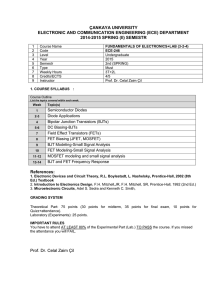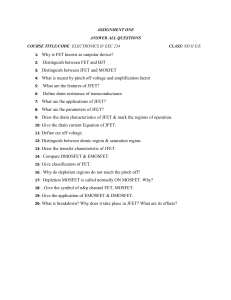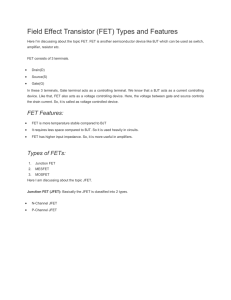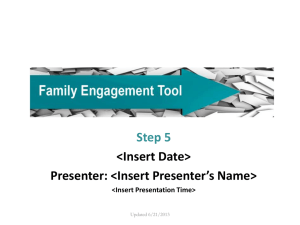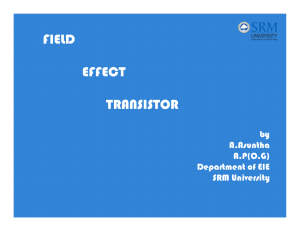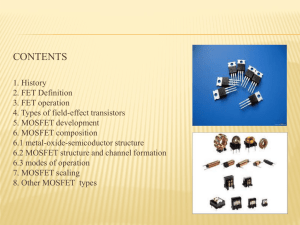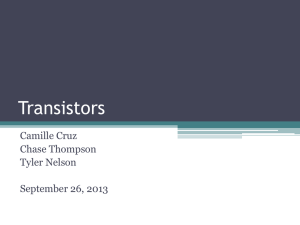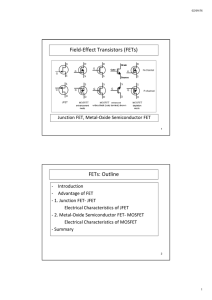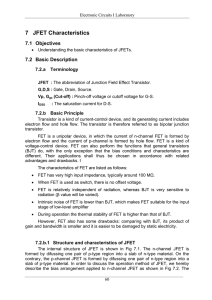PHYS225 Lecture 8
advertisement
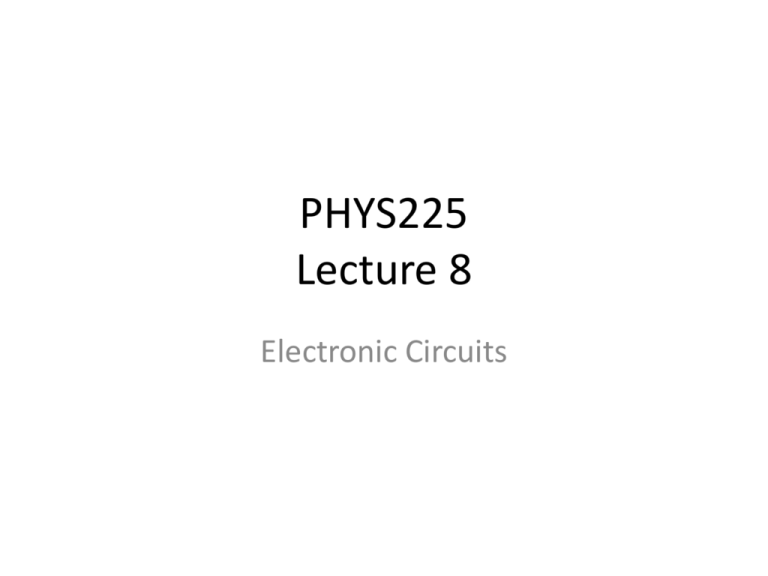
PHYS225 Lecture 8 Electronic Circuits Vcc Transistor Buffer in out R • In the schematic above (emitter follower), Vout = Vin 0.6 – – – – – – – sounds useless, right? there is no voltage “gain,” but there is current gain Imagine we change Vin by V: Vout changes by the same V so the transistor current changes by Ie = V/R but the base current changes 1/ times this (much less) so the “signal in” thinks the load is V/Ib = ·V/Ie = R the load is very high • The “buffer” is a way to drive a load without the driver feeling the pain (as much): it’s impedance isolation Last lecture – Field Effect Transistor • JFET • MOSFET – Can be thought of as a “voltage controlled resistor” • Voltage on “gate” controls impedance between “source” and “drain” • No current flows into gate – Input impedance is very high – There are n- and p-type FETs • As with BJT Field-Effect Transistors • The “standard” npn and pnp transistors use base-current to control the transistor current • FETs use a field (voltage) to control current • Result is no current flows into the control “gate” 2N7000 FET • FETs are used almost exclusively as switches – pop a few volts on the control gate, and the effective resistance is nearly zero FET Generalities FET • Every FET has at least three connections: – source (S) • Like emitter (E) on BJT – drain (D) • Like collector (C) on BJT – gate (G) BJT • Like base (B) on BJT • Some have a body connection too – though often tied to source note pinout correspondence FET Types • • • • Two flavors: n and p Two types: JFET, MOSFET MOSFETs more common JFETs conduct “by default” log current p-channel MOSFET n-channel MOSFET – when Vgate = Vsource • MOSFETs are “open” by default – must turn on deliberately • JFETs have a p-n junction at the gate, so must not forward bias more than 0.6 V • MOSFETs have total isolation: do what you want p-channel JFET n-channel JFET 4 2 0 2 Vgate Vsource 4 JFET Switch • An ideal switch would make a short-circuit connection when “on” and an open connection when “off.” In other words, it would behave like a mechanical switch. • The following switch quenches current flow when the JFET gate is reverse-biased below the cutoff level. JFET Switch On state = signal passed ► RDS ~ 25 - 100Ω Off state = open circuit ► RDS ~ 10 GΩ • Vout=Vin when switch is “on” • Vout=0 when switch is “off” • circuit behaves like a voltage divider when on. Vin d g s Vout R1 FET Switch Operates in Linear Regime • Switch “off” corresponds to VGS=VGS(off). • Switch “on” corresponds to VGS>VGS(off). • Ideally, RFET is small, i.e. IV slope is large below. linear regime 9 CMOS Switch • • • • Complementary MOSFET (CMOS) switch is most common. With this circuit, the output swing spans the full range. Note the absence of resistors; power is low. Q1 and Q2 are not “on” at same time -> no current! p-channel (pnp) n-channel (npn) Source Follower • A “source follower” circuit uses a FET in a circuit in which vs “follows” vg. • It converts the output impedance of a signal from high to low. This is useful for driving long cables with small signals. vs=Rid id=gmvgs=gm(vg-vs) vs=[Rgm/(1+Rgm)]vg gain=vs/vg=1/(1+1/Rgm) So, gain~1 for Rgm>>1. Note that gm is the transconductance, and 1/gm is the output impedance, typically ~a few hundred Ohms. By replacing the resistor with a current source, R~infinite, so gain is nearer to 1. Source Follower with Current Source • By replacing the resistor with a current source, R~infinite, so gain is nearer to 1. • The current source is made of a FET with grounded gate. FET Current Source: Schematic • A self-biased FET will deliver a nearly fixed current regardless of load if operated in the saturation region. ideal region for current source 13 FET Current Source: Biasing • The current source is most stable at VGS just above the cutoff voltage (VGS,off). • The is where the transconductance goes to zero. 14 FET Current Source: Parts • The following table gives output current versus bias resistance for a variety of parts. MOSFET Switches • MOSFETs, as applied to logic designs, act as voltagecontrolled switches – n-channel MOSFET is closed (conducts) when positive voltage (+5 V) is applied, open when zero voltage – p-channel MOSFET is open when positive voltage (+5 V) is applied, closed (conducts) when zero voltage • (MOSFET means metal-oxide semiconductor field effect transistor) drain source n-channel MOSFET gate p-channel MOSFET gate “body” connection often tied to “source” source + voltage 0V + voltage 5V 0V drain 5V 0V 0V 5V 5V <5V <5V Power Transistors • Additional material for current handling and heat dissipation • Can handle high current and voltage • Functionally the same as normal transistors

